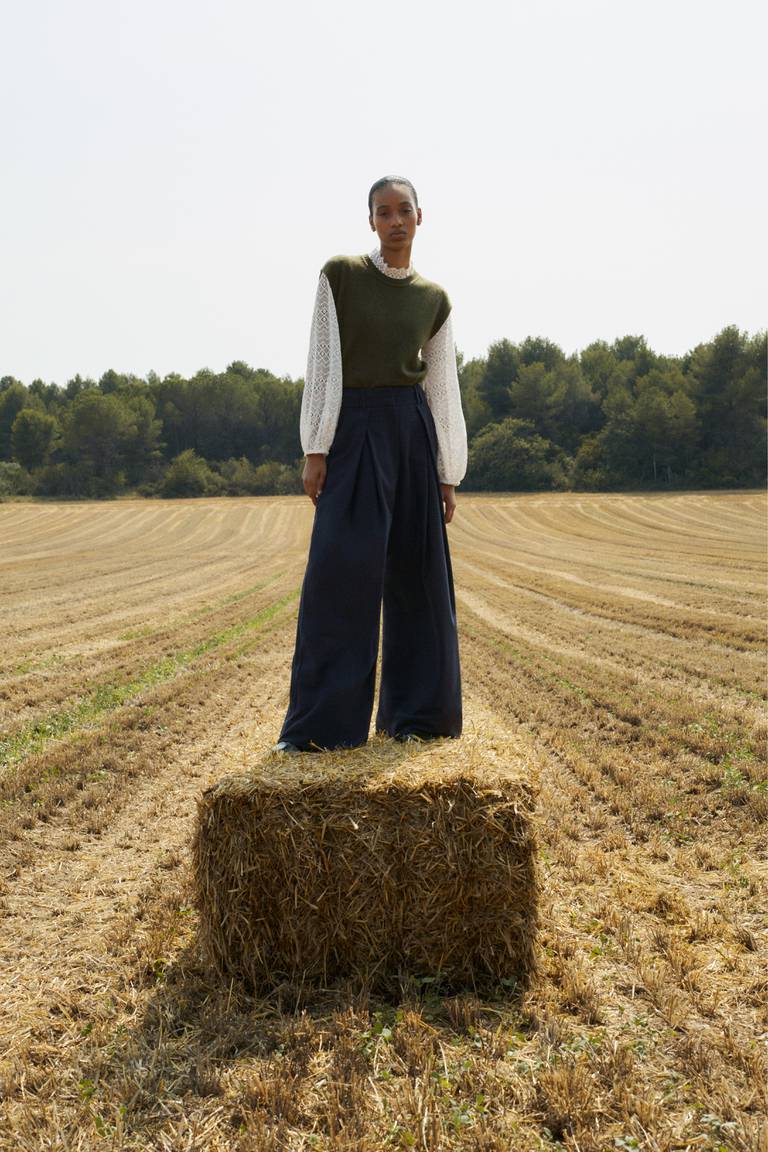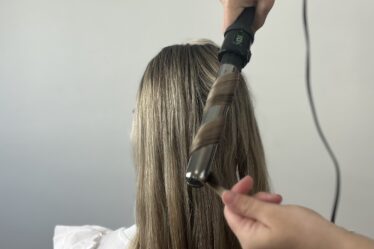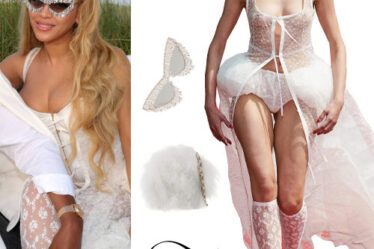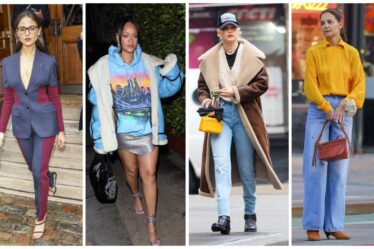
It’s not often that British brands breakthrough in America — but British accessible luxury label Me+Em is hoping to defy the odds.
For many years, the London-based direct-to-consumer label founded in 2009 operated under-the-radar. It sold accessible luxury pieces particularly popular among women in their 30s to 60s looking for practical, versatile and modern wardrobe staples such as £200 ($254) wide-leg trousers, £250 cashmere knits and easy-to-layer tops. The Princess of Wales, Kate Middleton, and Nicole Kidman were among Me+Em’s early fans.
But in recent years, the brand hit an inflection point, reaching profitability in 2019 before experiencing explosive growth. Revenues last year reached £80 million, up from £46 million the year previous and a more than four-fold increase on pre-pandemic levels. The brand is on track to surpass £100 million mark this year, the company said.
When digital marketing costs temporarily fell during the pandemic, Me+Em increased its investment, providing a boost. But Me+Em also benefited from a shift in dynamics over the pandemic, which saw its customer base grow rapidly.
Neighbourhood stores — of which Me+Em has a handful across London — benefitted as shoppers working from home stayed local. And while the era of wearing sweatpants 24/7 came to an end when lockdowns lifted, shoppers increasingly sought out clothing solutions that were smart enough for the return to the office but still provided the comfort and practicality they’d become accustomed to during quarantine. It was a sweet spot Me+Em had already finely honed, with its “fashion lego” approach to outfit building.
“We provide solutions for busy women. She could be busy working, she could be a busy mother, she could be busy socialising, she could be a busy traveller — or a combination of all four,” said founder Clare Hornby. “It’s really thinking about actually living in clothes, as well as looking good in them.”
Now, as the brand works to keep up the pacey momentum it’s experienced since the pandemic, Hornby and her team are targeting US expansion, looking to leverage its growing American customer base. To do so, Me+Em will need to find a way to translate the formula that works so well in its home market to an audience that’s larger, more diverse and already has plenty of fashion labels to choose from.
Function Meets Fashion
With her then-business partner Emma Howarth (who left the company in 2012), Hornby, a former advertising executive launched Me+Em 14 years ago with a quality-price ratio as the brand’s core principle, she said. Hornby saw a “gaping hole” in the British fashion market for designer-quality wares at a contemporary price point, opting for a digital-led, direct-to-consumer business model to deliver on the proposition.
Instead of seasonal collections, the brand produced monthly drops that catered to the immediate needs of shoppers at any given time of year, promoting the latest lines with a physical catalogue-style lookbook that is still mailed out to customers today.
At Me+Em, the end-use of the garment is just as important as how it looks, Hornby said. Necklines or cuffs must be easily adjustable, while tailored trousers or jackets may have smocking at the back so they’re more comfortable to wear and easy to move around in. Dresses and tops might have zips at the neckline rather than buttons, so those with larger busts can choose their break point easily. As Hornby puts it, all products must follow the three Fs: everything needs to be “flattering,” “functional” and, from a style perspective, have “forever appeal.”
“We put a lot of science into what we make, and really think about how women want to wear things,” she said, giving an example: “If you want to do a long cut-off [sleeve], you’ve got to have a mechanism for it. Because you want it to look beautiful and photograph amazingly and in a really cool way. But you also need to, at some point, do the washing up. Or eat some soup.”
It sounds simple, but few brands are able to work in these sorts of styling hacks effectively, said Charlotte Cowles, a 38-year-old freelance writer living in Brooklyn, New York, who has been a Me+Em shopper since spring 2021, drawn to items like a sweater with a removable collar that can be worn as a turtleneck or a crewneck.
“I’m a working mom, and I live in New York City, I’m moving a lot,” she said. “It takes some real craftsmanship to make things that actually function well.”
Hornby and Howarth initially self-financed the business before the company went on to secure venture capital, raising £1.5 million from Venrex Investment Management, Pembroke VTC and Sir Charles Dunstone in 2016, and an additional £900,000 from a crowdfunding campaign in 2017. Its dedicated fan base impressed Highland Europe, the private equity firm that bought out Pembroke last year.
“What you can rarely see in a consumer business is the customer cohorts improving over time,” said Highland principal Helena Prokhorenko. “[At Me+Em], customers spend more over time and are more loyal; they stick around for longer. There is a real product market fit.”
The vast majority of sales are driven by e-commerce, with its physical outposts, the first of which opened shortly after the brand launch, accounting for about 20 percent of annual revenue. The seven stand-alone locations, which are all “highly profitable,” according to chief operating officer Phil Mickler, are peppered around the London neighbourhoods where their customers live, including Notting Hill, Chelsea and Marylebone. (The brand also operates concessions in Selfridges and Harrods.) Its retail stores and physical catalogues are important marketing tools, said Mickler.
“It gives us a bit of diversification in terms of the marketing pitch, so we’re not overly reliant, like some businesses are, on Meta products,” he said. “It’s a bit of an antidote to the Instagram three-second attention span.”
Heading Stateside

Now, the brand is betting the same set-up will translate stateside. It plans to open two stores in New York before the end of the year in Manhattan’s SoHo and Upper East Side neighbourhoods, before adding an additional three to four stores next year. Eventually, the plan is to work towards a network of about 15 locations, mainly across New York and California.
Making a splash in the US won’t be easy, particularly without any wholesale support. The American market is its own fiercely competitive ecosystem, and it can be extremely expensive for startups to crack, as significant investment is needed to drive brand awareness. The sheer size of the market makes it logistically difficult, while American consumer tastes don’t always align with what works in the UK.
Over the past few decades, British chains from The Body Shop to Laura Ashley to Topshop have struggled to replicate their UK success in the US market. Since Asos outlined a big US expansion strategy in 2021, the retailer has failed to recruit new shoppers, with the number of active customers today flat compared with two years ago.
Hornby, who has no plans to enter into wholesale anytime soon, is reassured by the fact that the US was already Me+Em’s fastest-growing market without any investment in PR or stores — although the brand has now been working with some local influencers and run some TV ads recently to drum up excitement.
Plus, the product translates well, Hornby said, which is encouraging: “The same pricing quality gap exists there,” she said. “We’re really lucky in that a best seller in the UK is a best-seller in America.”
Among existing US customers, the brand’s push into the market will likely be very welcome.
“I’m excited that they’re coming to the US,” said Cowles. “If they did have a store here, I would definitely go.”



